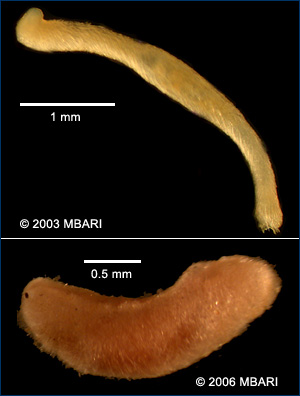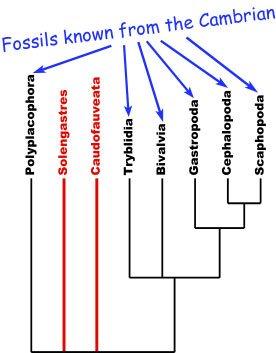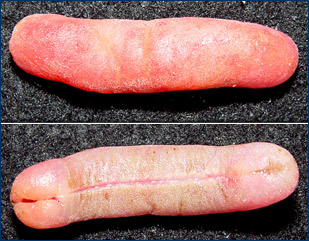
The Aplacophora
The naked molluscs
|
No. of described species: 320 |
 Two aplacophorans: Chaetoderma elegans (top) is a chaetodermomorph; the bottom photo is of an unidentified neomeniomorph. Note the glistening spicules on both. Click image to see more photos of aplacophorans at the Monterey Bay Aquarium Research Institute (MBARI) website. |
There is a good chance that Aplacophora is a paraphyletic group. The two groups of aplacophorans are the footless Caudofoveata (also known as Chaetodermomorpha) and the Solenogastres (or Neomeniomorpha).
Unfortunately, this group is understudied and thus species-level diversity is severely underestimated in this poorly collected group. The knowledge base that does exist is remarkable when one considers that this is primarily a deep-water taxon. However, molecular phylogenetic studies of this taxon are still few and its placement on the molluscan tree is problematic.
 |
Fossil record
There are no known fossils of aplacophorans. Partly due to spicules which are not interconnected and the difficulty of fossilizing soft body parts, it has been difficult to determine whether or not some problematic fossils belong to Aplacophora or not.
However, as you can see from the phylogeny at left, both groups of Aplacophora (shown in red) are considered to be basal members of Mollusca. Since many fossils representing the other basal groups have been found in rocks as old as the Cambrian (over 540 million years ago), it is probable that Aplacophora also existed during the Cambrian.
Perhaps it is just a matter of time before a fossil can be confidently determined to be a member of Aplacophora.
Life history & ecology
All aplacophorans are marine and many live in the deep sea (to 6000m or more).
Caudofoveates are burrowers that feed on detritus and bottom-dwelling microorganisms, while solenogasters feed on cnidarians. Both groups have a radula and lack true nephridia.
More on morphology
 Dorsal (top) and ventral views of a large neomeniomorph aplacophoran Neomenia yamamotoi, from the Gulf of Alaska. The animal is 11 cm in length. |
Overall, the aplacophoran body plan is similar to that of the chitons. Aplacophorans and polyplacophorans differ from the monoplacophorans by having a dorsal gonad rather than a posterior gonad. The pericardium is similar in all three groups as are many of the other organ systems and positions. Major differences are found in the type of spicules secreted by the dorsal mantle epidermis.
The internal anatomy provides evidence of the molluscan identity of aplacophorans. In both groups the anterior end of the alimentary system includes a radula and odontophore (the radula's muscular support). In the Chaetodermomorpha the radula and odontophore are strongly developed, and the alimentary system is more differentiated than in the Neomeniomorpha. Both groups have a dorsal gonad that opens into the pericardium, a chamber which encloses the heart. From the posterior portion of the pericardium, a duct (actually several coelomoducts) extends out and loops around before ultimately opening into the pallial cavity. The nervous system is simple and ladder-like with a well-developed cerebral ganglion.
Radular configurations are quite variable and show a wide range of tooth development and modifications that include jaw-like structures, denticles with cones, and sweepers. This is second only to the range of radular variation found in gastropods and is in marked contrast to the lack of variation found in Monoplacophora, Polyplacophora, and Scaphopoda.
Original text by Paul Bunje, 2003. Neomenia yamamotoi courtesy of www.jaxshells.org.